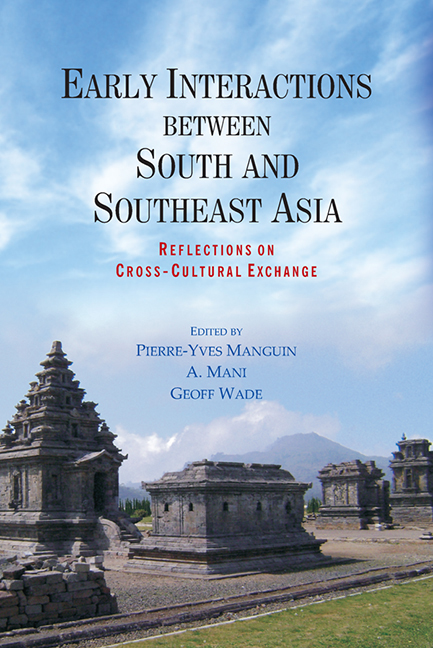Book contents
- Frontmatter
- Contents
- FOREWORD
- Preface
- Introduction
- PART I New Archaeological Evidence from South Asia and Southeast Asia
- PART II Localisation in Southeast Asia
- 11 Tamil Merchants and the Hindu-Buddhist Diaspora in Early Southeast Asia
- 12 The Spread of Sanskrit in Southeast Asia
- 13 The Early Inscriptions of Indonesia and the Problem of the Sanskrit Cosmopolis
- 14 Indian Architecture in the ‘Sanskrit Cosmopolis’: The Temples of the Dieng Plateau
- 15 The Importance of Gupta-period Sculpture in Southeast Asian Art History
- 16 Individuals under the Glaze: Local Transformations of Indianisation in the Decorative Lintels of Angkor
- 17 Early Musical Exchange between India and Southeast Asia
- 18 Buddhism and the Circulation of Ritual in Early Peninsular Southeast Asia
- 19 Early Buddhism in Myanmar: Ye Dhammā Inscriptions from Arakan
- 20 Hindu Deities in Southern Vietnam: Images on Small Archaeological Artefacts
- 21 ‘The Depositing of the Embryo’ – Temple Consecration Rituals in the Hindu Tradition of South and Southeast Asia: A Study of the Textual and Archaeological Evidence
- 22 Localisation of Indian Infl uences as Refl ected in the Laotian Versions of the Ramayana
- 23 Broken Threads: Contested Histories of Brahminism in Cambodia and Thailand and the Construction of Ritual Authority
- LIST OF CONTRIBUTORS
- INDEX
22 - Localisation of Indian Infl uences as Refl ected in the Laotian Versions of the Ramayana
from PART II - Localisation in Southeast Asia
Published online by Cambridge University Press: 21 October 2015
- Frontmatter
- Contents
- FOREWORD
- Preface
- Introduction
- PART I New Archaeological Evidence from South Asia and Southeast Asia
- PART II Localisation in Southeast Asia
- 11 Tamil Merchants and the Hindu-Buddhist Diaspora in Early Southeast Asia
- 12 The Spread of Sanskrit in Southeast Asia
- 13 The Early Inscriptions of Indonesia and the Problem of the Sanskrit Cosmopolis
- 14 Indian Architecture in the ‘Sanskrit Cosmopolis’: The Temples of the Dieng Plateau
- 15 The Importance of Gupta-period Sculpture in Southeast Asian Art History
- 16 Individuals under the Glaze: Local Transformations of Indianisation in the Decorative Lintels of Angkor
- 17 Early Musical Exchange between India and Southeast Asia
- 18 Buddhism and the Circulation of Ritual in Early Peninsular Southeast Asia
- 19 Early Buddhism in Myanmar: Ye Dhammā Inscriptions from Arakan
- 20 Hindu Deities in Southern Vietnam: Images on Small Archaeological Artefacts
- 21 ‘The Depositing of the Embryo’ – Temple Consecration Rituals in the Hindu Tradition of South and Southeast Asia: A Study of the Textual and Archaeological Evidence
- 22 Localisation of Indian Infl uences as Refl ected in the Laotian Versions of the Ramayana
- 23 Broken Threads: Contested Histories of Brahminism in Cambodia and Thailand and the Construction of Ritual Authority
- LIST OF CONTRIBUTORS
- INDEX
Summary
The paper addresses the wider issue of regional culture and localisation of Indian influences, taking into account the Ramayana theme in the Mekong River basin. The Laotian Ramayana, its literary versions, its oral variants and fine art renderings have been used to illustrate the process in its actual operation.
How do the local Laotian writers, storytellers and painters use the legend of Rama to produce their own social space, locating all the incidents of the Indian epic in the Mekong valley from Vientiane to Phnom Penh? In what way do they transform the Indic story to express the cultural ethos of the Mekong ethnic communities? How do they resolve the Lao/Tai endemic issues of bride price, sibling rivalry, etc.? What is the pedagogical use of the Ramayana to teach the local geography at the innumerable Buddhist monasteries along the Mekong? How did the Ramayana survive in Laos after the fall of monarchy and installation of the Communist regime, leading to the establishment of the Phra Lak Phra Lam Theatre at the Royal Palace, now turned into a museum at Luang Prabang? While attempting to answer these pertinent questions in the light of written versions of the Laotian Ramayana, I would also present the panels of mural paintings of a Vientiane Buddhist monastery to illustrate the process of localisation.
So far four written versions of the Rama story are known in Laos. They are:
The Phra Lak Phra Lam (The August Laksmana, The August Rama) The Khvay Thuaraphi (The Buffalo Dundubhi) The Phommachak (Brahmacakra) The Lanka Noi (The Little Lanka)
THE PHRA LAK PHRA LAM
Six parallel palm-leaf manuscripts of the Phra Lak Phra Lam (A-F) recovered from different parts of Laos formed the basis of a critical and collated edition of the text which I prepared and published from Vientiane. A manuscript from the village Ban Naxon Tai, 40 km from Vientiane and, consisting of forty-three sections divided into four parts, provided the basic text (MS D). Other Vientiane manuscripts, particularly that of Mr Chan Kam of the Village Ban Hom (MS D) offered readings which closely correspond to the Ban Naxon manuscript.
- Type
- Chapter
- Information
- Early Interactions between South and Southeast AsiaReflections on Cross-Cultural Exchange, pp. 443 - 460Publisher: ISEAS–Yusof Ishak InstitutePrint publication year: 2011



